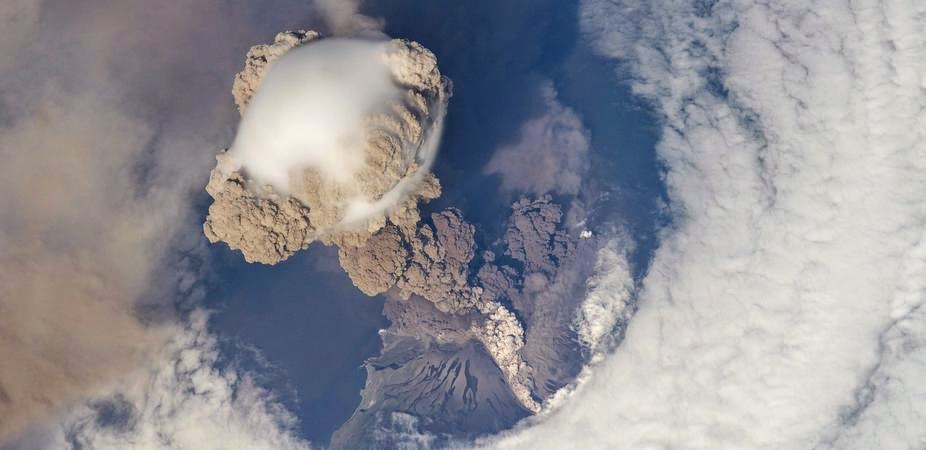
You can learn a lot about volcanoes by studying explosions. The more we can learn about their explosive behaviour, the more chance we have of saving lives when they suddenly erupt.
There are many volcanoes on the planet today – some still active such as Russia’s Sarychev Peak (above) and Kilauea, on Hawaii’s Big Island, and others currently dormant including the beautifully symmetrical Mount Fuji in Japan.
But there are also certain volcanic systems that misbehave. They are concealed beneath the surface of the planet, and we often only realise they’re there when they erupt.
The problem with trying to determine how such concealed, complex natural processes work is that dissecting them and looking at them piece by piece does not allow the process itself to operate and be observed.
Or, as author Douglas Adams once said, if you try and take a cat apart to see how it works, the first thing you have on your hands is a non-working cat.
So what better way is there to find out how volcanoes work than creating your own explosions?
How to build a volcano
I’m part of a research group, spread across three continents, whose work involves the use of explosive experimentation to support or refute some theories about particular volcanic eruptions.
In order to address the problem of concealed, subterranean volcanic systems, we designed a series of experiments – from small benchtop-scale to large field-scale ones – to try to work out how these particular volcanoes, named maar-diatreme systems, work.
The benchtop experiments, done at the University of Würzburg in southern Germany, used blasts of highly pressurised argon gas fired into a tank full of extremely small glass beads. The entire event is captured on a high-speed camera at up to 20,000 frames per second.
The bursts of argon gas represent the explosive blast within a volcanic edifice and the glass beads represent the granular rock mass making up the volcanic geology.
As it turns out, if you give solid glass beads enough kinetic energy through a sufficiently explosive blast, they no longer behave like a solid.
Instead, they flow like a liquid, with ripples coursing through the bead system. Gas cavities form, collapse and recoil as the flowing masses of glass beads are thrown into each other by the violently expanding and depressurising gas bubble.
As the cavity breaches the surface, a depression crater is formed, and material is blasted violently outwards over the simulated landscape.
The red beads buried within the firing mechanism, representing the magma, rise to the surface completely separately from the initial, cavity-forming blast.
Even if you create smaller blasts where the magma or cavity doesn’t actually breach the surface, a crater is still formed.
When I looked at the mathematics of the bead explosion I deduced an equation that numerically describes the segregation of the explosive gas cavity and the fountaining, particulate magmatic mass.
Essentially, this equation describes a process termed “dynamic segregation”. The shallower and more powerful the initial explosion, the greater the time delay between the emergence of the gas cavity and the emergence of the magmatic fountain. At a certain depth, this effect becomes non-existent.
The equation also states that the shallower blasts put a lot more energy into crater excavation than forcing the magma to rise up out of the underground reservoir.
So not only are shallower blasts producing larger craters, but they utilise far more of the kinetic energy from the original blast, making them even more dangerous to be nearby than previously thought.
We’re going to need a bigger explosion
But why stop there? Field-scale experiments were introduced into the mix at Buffalo, in the US state of New York.
TNT explosives, primed with a wired charge, were buried around a bunker in pre-arranged set-up of gravel, concrete and other materials to represent layers of deep, volcanic rock.
The charges were detonated, and the resulting debris field and crater excavations were again captured on a high-speed camera. Diggers were brought in to slice the craters in half to give us a two-dimensional cut-out perspective of the newly formed holes in the ground.
These experiments, while satisfyingly loud and literally earth shattering, revealed little about the subsurface processes, simply because we couldn’t directly observe them in this case.
Nevertheless, we did confirm some important ideas about underground blasts. The most important thing being that, based on the size of the final crater, you can mathematically determine how explosive a single blast was – and how extensive the surrounding damage will be – with striking precision.
Significantly, this matched up with the predictions and calculations produced from the benchtop-scale experiments, which showed a clear link between initial argon pressure (and therefore explosion energy) and crater size.
It’s more than just making a mess
These experiments give us very detailed and scalable models of explosion energies, allowing us to predict the explosive energies of concealed volcanic systems around the world.
Consequently, one of the many benefits of this research is the ability to save lives – we’ll now know much more accurately than ever before the scale of destruction these volcanic systems are capable of unleashing.
The tricky part, of course, is finding them in the first place.
Video:
Note : The above story is based on materials provided by The Conversation (under Creative Commons-Attribution/No derivatives).









